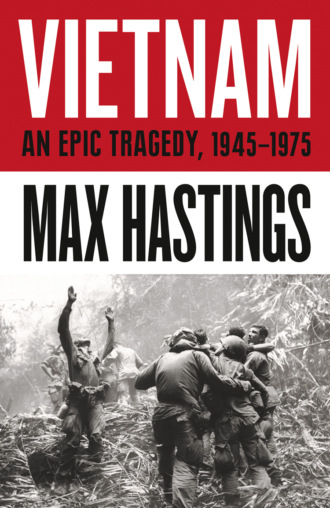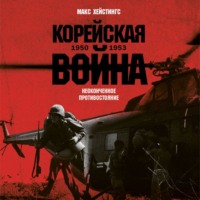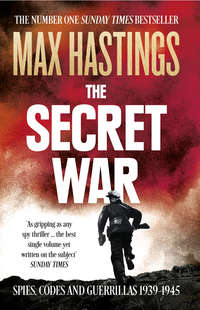
Полная версия
Vietnam: An Epic History of a Divisive War 1945-1975
This seems heroically naïve: most normal human beings crave escape from an experience that is inflicting grief and hardship on themselves and loved ones. Many of those in the West who opposed the war made a well-founded assessment that the US was doing something unlikely to succeed, employing grievously haphazard violence. Some then went a step further, adopting a view that if their own nation had embraced a bad cause, the other side’s must be a good one. Yet the Hanoi politburo and National Liberation Front caused the South Vietnamese people merely to exchange oppression by warlords and landlords in favour of even harsher subjection to disciples of Stalin. Democracy allows voters to remove governments with which they are dissatisfied. Once communist rule has been established, however, no further open ballot is indulged, nor has been under Hanoi’s auspices since 1954.
In conducting its war effort, the Northern politburo enjoyed significant advantages. Its principals were content to pay an awesome price in human life, secure from media or electoral embarrassments. They could suffer repeated failures on the battlefield without risking absolute defeat, because the US had set its face against invading the North. By contrast, when the South lost once, its fate was irreversible. There are significant parallels between the Vietnamese communists’ struggle and the Soviet Union’s 1941–45 war effort: Stalin yoked patriotism, ideology and compulsion in just the fashion emulated by Ho Chi Minh and Le Duan a generation later. Beyond peradventure the communists proved more effective warriors than the soldiers of Saigon, but it seems prudent to hesitate before anointing them the good guys in this saga.
Much of the narrative below depicts cruelties and follies, yet within the big canvas many individuals, Vietnamese and American, of all ages and both sexes, military and civilian, behaved decently. I have sought to tell stories of such people, because it is mistaken to allow virtuous endeavour to vanish into the cauldron of bomb blasts, brutalities and betrayals from which most accounts of the war are served up. I decided not to conduct primary political research: US archives have been trawled by scholars for decades; exhaustive accounts exist of the Western participants’ decision-making, notable among them those of Fredrik Logevall. Ken Hughes’ 2015 rendition and analysis of the White House tapes have established an almost incontrovertible record about the thinking and decision-making of Nixon and Kissinger that ended in the January 1973 Paris Accords, and supersedes much of the self-serving narrative presented in the participants’ memoirs. However, I have spent many hours studying testimony in the US Army’s Military Heritage and Education Center at Carlisle, Pa., and the US Marine Corps’ Archive at Quantico, Va. I have also accessed online material from Texas Tech University’s Vietnam War Study Center at Lubbock, and conducted almost a hundred interviews with survivors of all ages and both sexes, American and Vietnamese. Thanks to the indispensable aid of Merle Pribbenow, I have read many thousands of pages of translated Vietnamese memoirs, documents and histories.
Any historian such as myself, publishing a 2018 study of Vietnam, should acknowledge a debt to the recent Burns-Novick TV documentary series, which around the world has reawakened consciousness about this epochal struggle. I hope that my own work conveys something of the enormity of the experience the Vietnamese people endured over three generations, from the consequences of which they remain unliberated to this day.
MAX HASTINGS
Chilton Foliat, Berkshire, and Datai, Langkawi, Malaysia
May 2018
* Described, along with other experiences of conflict, in the author’s 2000 memoir Going to the Wars.
Note on Styles Adopted in the Text
Viet Nam is represented thus by its own people; in the interests of accessibility, however, I sustain the Western custom of using Vietnam, just as I render Ha Noi, Sai Gon, Dien Bien Phu, Da Nang and Viet Cong as single words.
The Vietnamese language makes extensive use of tone marks. I omit these in my text, but in the bibliography and index all proper names are appropriately accented.
Vietnamese names are commonly triple-barrelled, with the family name coming first, and I have adhered to this convention. Many Westerners are bewildered by the profusion of Vietnamese called Nguyen, but this is an accident beyond my undoing.
Wherever possible without forfeiting coherence I omit province names, to avoid crowding the narrative with geographical detail.
Translations often yield stilted prose. When quoting from foreign-language documents and memoirs in all my books, I respect Dryden’s admonition that a translator ‘should not lackey behind his author, but mount up beside him’. Thus, I seek to convey Vietnamese and French conversations in colloquial English.
‘African American’ is a modern term; in the Vietnam era, the word ‘black’ was used, and thus I retain it here. I cite an American’s race only where this seems relevant.
Ranks attributed are those held at the time of episodes described.
North and South Vietnam are capitalised thus when referenced as separate states, but lower-cased as north and south when the country was unified pre-1954 and post-1975.
All the combatants measured distances metrically. I nonetheless adopt feet, yards and miles, even in direct quotations.
The colloquial phrase for joining South Vietnam’s communist guerrillas was ‘ra bung’ which meant ‘going out into the marshes’, rather as some French World War II Resistants designated themselves maquisards, because they sought refuge in the maquis wilderness. Vietcong and its abbreviation ‘VC’ were South Vietnamese slang terms, but too familiar not to retain here.
American spellings are used in quoted speech by Americans, or in a conspicuously American context, for instance ‘secretary of defense’.
In thematic sections – notably, about the experience of combat – personal experiences from different periods of the war are sometimes merged, where this does not distort their significance and validity.
Timings of military operations are given by twenty-four-hour clock, but otherwise in accordance with twelve-hour civilian practice.
No attempt seems plausible to set a value upon the South Vietnamese piaster against the US dollar, since chronic inflation and unrealistic official exchange rates render no comparison valid for more than a short period of the wartime era.
Glossary
AFN US Armed Forces Network radio stations
AK-47 Soviet-designed Kalashnikov assault rifle of which a Chinese variant began to be issued in quantity to Vietnamese communist forces in 1965
APC armoured personnel-carrier, most often in Vietnam the tracked M-113
ARVN Army of the Republic of [South] Viet Nam, pronounced as ‘Arvin’
bangalore torpedoes explosive charges packed in sections of metal or bamboo tubing, for breaching wire entanglements
battalion military unit, comprised of 400–1,000 men, normally organised in three/four companies and a headquarters
boonie-rat slang term for US infantry soldier
brigade military headquarters, controlling up to 5,000 men
cadre communist functionary
CAP combat air patrol
cherry green infantryman
chieu hoi literally ‘welcome return’, name of Saigon’s programme to process and rehabilitate defectors from the VC or NVA, often used to categorise the many thousands who joined it – ‘He’s a chieu hoi’
CIA Central Intelligence Agency
Claymore M-18 directional anti-personnel mine, spraying a hundred steel balls across a 40-degree arc, triggered manually or remotely
company military unit, a captain’s command, comprised of 100–180 men, in three or four platoons
CORDS Civilian Operations and Revolutionary [later changed to Rural] Development Support
corps military headquarters directing two/three divisions, commanded by a lieutenant-general
COSVN communist headquarters – the Central Office for South Vietnam, or Trung Uong Cuc Mien Nam, usually located near the Cambodian border
CP command post
division military formation, comprised of 8–15,000 men, organised in two/three brigades, commanded by a US major-general or sometimes by a Vietnamese colonel
DMZ the Demilitarized Zone, created near the 17th Parallel by the 1954 Geneva Accords, separating the new North and South Vietnams
dust-off slang for a medevac helicopter
DZ dropping zone for paratroops
ECM electronic counter-measures deployed by US aircraft against North Vietnamese ground defences
FAC forward air controller
flak slang term for anti-aircraft fire
FO [artillery or mortar] forward observer, accompanying infantry
FOB forward operating base
FSB fire support base
GCMA French special forces – Groupement de Commandos Mixtes Aéroportés
grunt slang term for US infantry soldier
hooch slang term for soldiers’ quarters, alternatively a bunker or hut
ICC International Control Commission, established under the 1954 Geneva Accords with Indian, Polish and Canadian membership to monitor implementation. It persisted, albeit little heeded, until the 1973 Paris Accords, following which it was supplanted by a new
ICCS, International Commission for Control and Supervision, which had a wider membership to address an alleged 18,000 ceasefire violations, but proved equally ineffectual
JCS US Joint Chiefs of Staff
Kit Carson scouts NVA or VC defectors serving with US units
LAW shoulder-fired 66mm Light Anti-tank Weapon, used by US and South Vietnamese forces
LRRP long-range reconnaissance patrol
LZ landing zone for a helicopter assault – a ‘hot’ LZ was one defended by the enemy
M-14 US Army 7.62mm semi-automatic infantry rifle, standard until 1966–68, when progressively withdrawn
M-16 5.56mm rifle, a much lighter automatic weapon than the M-14 that it replaced, of which 1966–68 versions proved prone to jam in action
MACV Military Assistance Command Vietnam, US headquarters in Saigon – pronounced ‘Mac-V’
MEDCAP Medical Civil Action Program – deployment of military medical teams to provide care to the civil population
montagnards originally French term for Vietnamese hill tribes, often abbreviated by Americans to ‘Yards’, who were almost universally anti-communist and often recruited by special forces as irregulars
NLF National Liberation Front: the supposed political coalition – in reality entirely communist-run – movement, established in 1960 to promote and direct Southern resistance to the Saigon government
NSC National Security Council
NVA North Vietnamese Army, a contemporary American usage adopted below, in preference to the more common modern PAVN, People’s Army of Vietnam
platoon element of 30–40 men, normally four to each company, customarily commanded by a lieutenant, seconded by a sergeant
PRC-10, later replaced by PRC-25, US infantry voice radio set, weighing 23.5lb including battery. A company commander might be accompanied by up to three RTOs – operators – each carrying a set tuned to different nets
PRG Provisional Revolutionary Government-in-waiting created by the communists in June 1969 to supersede the NLF. It was initially located at COSVN, then from February 1973 at South Vietnam’s ‘provisional capital’ at Loc Ninh, north of Saigon
RoE Rules of Engagement, whereby US forces were permitted to attack communist forces and installations; entirely different in South and North Vietnam, Laos and Cambodia, and varied during the course of the war
recoilless rifle relatively portable Soviet-designed short-range artillery pieces ranging in calibre from 57mm to 106mm, that could penetrate armour at a range of 500 yards, or propel an explosive bomb up to 4,000 yards, mounted either on a tripod or a two-wheeled carriage; extensively used by the VC and NVA
regiment military unit normally composed of three battalions, commanded by a full colonel
RF, PF Regional Forces, Popular Forces – militias recruited by Saigon for local defence, lightly-armed and commanded by province chiefs, totalling 525,000 men and sometimes known as Ruff-Puffs
RPG rocket-propelled grenade-launcher, a superbly effective communist shoulder-fired weapon, delivering a rocket with a range of 150 yards, that could penetrate seven inches of armour
R&R rest and recuperation – a week-long out-of-country leave granted to all US personnel at least once during a Vietnam tour, usually in Hawaii, Hong Kong or Australia
SAC USAF Strategic Air Command, of which the B-52 bomber force was the principal component
SAM Soviet-built surface-to-air missile, most commonly the SAM-2, deployed in North Vietnam from 1965
sappers VC and NVA elite spearhead units, specially trained in the use of explosives
SF Special Forces
‘short’ a term used by US soldiers – ‘I’m short’ – to denote a man close to his DEROS – Date of Estimated Return from Overseas Service, and thus exceptionally reluctant to die
slick troop transport helicopter, most often a Huey
SOP standard operating procedure
squad normally four in an infantry platoon, comprised of 8–10 men commanded by an NCO, subdivided into fireteams
USIA US Information Agency
Vietcong or VC derives from term Cong San Viet Nam, meaning Vietnamese communist, progressively adopted from the late 1950s
Vietminh common usage for the Viet Nam Doc Lap Dong Minh Hoi, Vietnamese communist front organisation founded in 1941
1
Beauty and Many Beasts
1 CLINGING TO AN EMPIRE
Let us start this long tale, tragic even among the myriad tragedies of wars, not with a Frenchman or an American, but with a Vietnamese. Doan Phuong Hai was born in 1944 in a village on Route 6 only eighteen miles from Hanoi, yet wholly rustic. Among Hai’s earliest memories was that of wire, barbed wire, the rusty strands that encircled the French army post on a hillock near the marketplace, and the manner in which they sang when the wind blew through them. Behind the wire and beneath France’s fluttering tricolour flag lived a Vietnamese trumpeter named Vien, whom the little boy loved. Vien gave him empty butter tins and metal bottle caps, from which he built and cherished a toy car. Hai would sit among a little cluster of admiring children listening to Vien’s tales of his many battles, peering at the scar from a leg wound he had received at Limestone Mountain where he blew the call for a charge in which Foreign Legionnaires claimed to have killed a hundred communists. The boys stroked the sergeant’s stripes and hoarded empty cartridge cases that he occasionally gave to them.
Sometimes Vien would sing in a deep, sad voice, perhaps about his mother who had died in the previous year. Then, as a special treat, he led his small followers down to the riverbank and played in succession the bugle calls of the army, ‘some that made our hearts thrill to the notes, others so sad that they made one want to cry’. Then came a day in 1951 when Hai’s family moved to Hanoi, taking all their possessions aboard the aged district bus. Vien was commanding a picket by the roadside, and gave him parting gifts of two pieces of chewing gum and a gentle tug on the ear. As the bus pulled away, the boy saw him waving through a cloud of red dust behind, as houses, paddy fields, bamboo groves and da trees at the end of the village disappeared from his own life forever. Hai embarked upon a succession of journeys, exiles, a few joys and many misfortunes, such as were the shared experience of the Vietnamese people for half a century. Though he himself became a soldier, never again would warriors be imbued in his eyes with the glow of romance conferred upon them by Sergeant Vien and his bugle.
Vietnam endured a thousand years of rule by the Chinese before their expulsion in 938; they returned several times, and were finally driven out only in 1426. Thereafter the country enjoyed independence, though by no means stability or good governance. Rival dynasties controlled the north and south respectively until 1802, when Emperor Gia Long imposed unity, ruling from the city of Hue. During the late-nineteenth-century scramble for empires, France fixed its attentions on Indochina, and by force of arms established a progressive dominance, initially in the south, Cochinchina. In May 1883, when the National Assembly in Paris voted five million francs for an expedition to consolidate the region as a ‘protectorate’, the conservative politician Jules Delafosse proclaimed, ‘Let us, gentlemen, call things by their name. It is not a protectorate that you want, but a possession.’ So it was, of course. The French committed twenty thousand troops to securing Tonkin – northern Vietnam. Achieving this after a year’s hard fighting, they imposed a ruthless governance. While they abolished the old custom of condemning adulteresses to be trampled to death by elephants, the penalty of beheading, formerly imposed only upon thieves, was extended to all who challenged French hegemony. Opium consumption soared after the colonial power opened a Saigon refinery.
Vietnam comprises 126,000 square miles, a few more than Italy or metropolitan France, most of which are mountainous and shrouded in exotic vegetation, or flatland of extraordinary seasonal wetness and fertility. Almost every visitor who escaped the penance of exertion in the clinging heat was awed by its beauty and penned lyrical descriptions, celebrating views of ‘paddy fields in which water buffalo grazed, almost every one with a white egret perched on its back picking at insects; of vegetation so bright and green that it hurt the eyes; of waits at ferries beside broad rivers the colour of café crème; of gaudy pagodas and wooden homes on stilts, surrounded by dogs and ducks; of the steaming atmosphere, the ripe smells and water everywhere, giving a sense of fecundity, of nature spawning, ripening and on heat’.
Westerners rejoiced in the sublimity of Vietnamese weaving skills, manifested in thatch, basketwork and conical coolie hats. They peered curiously at the exotic dead creatures purveyed on street stalls, the profusion of fortune-tellers, dice-throwers, spices. Jungle butterflies grew as big as bats. There was a glorious water culture: sampans glided up rivers and canals where carts could not creak; fishing was fun, as well as a prolific source of food. Visitors described cockfights and gambling hells; glittering ceremonies in the imperial palace at Hue where the French indulged a puppet emperor who held banquets surmounted by roast peacock, said to taste like tough veal. The coastal region around the old capital was regarded with considerable suspicion by inhabitants of the Mekong delta, who said ‘The mountains are not high nor the rivers very deep, but the men are deceitful and the women over-sexed.’ A Westerner who loved the Vietnamese wrote that they spoke in cadences that made them ‘sound to me like charming ducks: their monosyllabic language comes out in a series of sweet quacks’.
Among fifty ethnic groups, the wildest tribes shared the wildest regions of Annam with tigers, panthers, elephants, bear, boar and a few Asian rhino. Two great deltas, those of the Red River in the north and the Mekong in the south, yielded prodigious agricultural produce. A boom in the rice export trade prompted a French land-grab at the expense of native peoples, matching those conducted by Americans in their own West and by British colonists across swathes of Africa. The peoples of Indochina were taxed to fund their own subjection, and by the 1930s 70 per cent of peasants were reduced to tenantry or smallholding. French planters – a few hundred families who accumulated colonial Indochina’s great fortunes – adopted in the twentieth century an uncompromising attitude towards the Vietnamese, in the words of a British visitor ‘identical with that of any of the old slave-owning aristocracies. It is one of utter contempt; without which effective exploitation would probably be impossible.’
French plantocrats, rubber magnates and coal-mine owners were indulged in institutionalised cruelty towards their workforces by the colonial administration, which also imposed an artificially high exchange rate for the franc against the local piaster that further enriched the Paris exchequer. The invaders were successful in imbuing many Vietnamese with their language, education and culture. A schoolboy recalled being taught in class that his forebears were Gauls. He learned better only when his father, an NCO in the French army, told him sternly and proudly, ‘Your ancestors were Vietnamese.’ An Australian surgeon wrote of a consciousness, even among relatively humble people, ‘of their long unbroken history and ancient civilization’.
Their circumstances were slightly better than those of the Congolese ruled by Belgium; somewhat worse than those of Indians under the British. There was a contradiction about the lives of upper- and middle-class Vietnamese. Compulsorily immersed in a European culture and language, they nonetheless saw little of French people outside working hours. Nguyen Duong, born in 1943, grew up with a passion for Tintin and French spy stories. Yet like all Asians, to whom a physical blow is the worst of insults, at his school he recoiled from French teachers’ habitual slapping of dunces. He never knew his parents to entertain a colon family, nor to dine out with such people. Norman Lewis described Saigon as ‘a French town in a hot country. It is as sensible to call it the Paris of the Far East as it would be to call Kingston, Jamaica, the Oxford of the West Indies. Its inspiration has been purely commercial and it is therefore without folly, fervour or much ostentation … Twenty thousand Europeans keep as much as possible to themselves in a few tamarind-shaded streets.’
Colonial life seemed to most of its beneficiaries infinitely comfortable and agreeable – for a time. Those who lingered too long, however, risked worse diseases than malaria or dysentery: the crippling lassitude of the East, compounded by opium and access to many servants. Old French hands – les anciens d’Indo – spoke of le mal jaune. Mastery did not spare them from the disdain of Indochina’s upper-crust native inhabitants. It was a Vietnamese tradition to blacken teeth with enamel, which caused them to regard white fangs with disdain: an emperor demanded, on receiving a European ambassador, ‘Who is this man with the teeth of a dog?’ Norman Lewis wrote: ‘They are too civilized to spit at the sight of a white man, but they are utterly indifferent … Even the rickshaw coolie, given – to be on the safe side – double his normal fee, takes the money in grim silence and immediately looks away. It is most uncomfortable to feel oneself an object of universal detestation, a mere foreign-devil.’
Few Vietnamese regarded French rule with equanimity, and local revolts were commonplace. In 1927 the Mekong delta village of Vinh Kim spawned a remarkable band of teenage performers called the United Women’s Troupe, which staged anti-colonialist shows and plays. The 1930s witnessed rural demonstrations, crop-burnings, insurgencies. A relentless debt squeeze caused some peasants to be imprisoned for non-payment of taxes, others to be so harrowed by loan sharks that by 1943 almost half of Vietnam’s land was in the hands of less than 3 per cent of its farmers. The colonial authority was confident that repression was the best medicine. A Vietnamese sûreté officer taunted an arrested revolutionary: ‘How can a grasshopper kick an automobile?’
Guerrilla and bandit groups nonetheless persisted in the country’s many wildernesses – ‘les grands vides’. On the terrible prison island of Poulo Condore, cells were seldom empty. There was little pretence of due process for Vietnamese consigned there, and the place became known as ‘the revolutionary university’. Many of those who later played prominent roles in the independence struggle served time there. Indeed, the man who became their leader, one of the most famous revolutionaries of the twentieth century, was among the few who did not.










